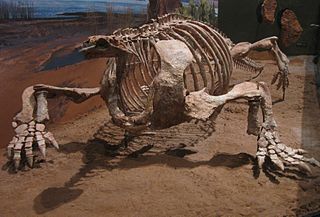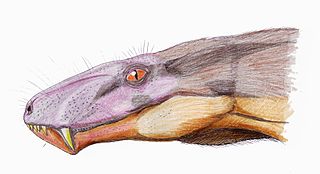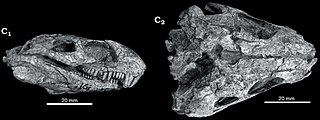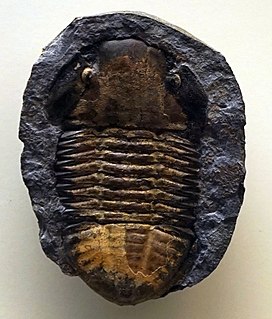 W
WAerosaurus is an extinct genus within Varanopidae, a family of non-mammalian synapsids. It lived between 252-299 million years ago during the Early Permian in North America. The name comes from Latin aes (aeris) “copper” and Greek sauros “lizard,” for El Cobre Canyon in northern New Mexico, where the type fossil was found and the site of former copper mines. Aerosaurus was a small to medium-bodied carnivorous synapsid characterized by its recurved teeth, triangular lateral temporal fenestra, and extended teeth row. Two species are recognized: A. greenleeorum (1937) and A. wellesi (1981).
 W
WAiniktozoon loganense is an enigmatic fossil organism from the Silurian of Scotland. Originally described as an early chordate, recent studies suggest that it was in fact an arthropod, more precisely a thylacocephalid crustacean.
 W
WAmphipithecus mogaungensis was a primate that lived in Late Eocene Myanmar. Along with another primate Pondaungia cotteri, both are difficult to categorise within the order Primates. What little is known suggests that they are neither adapiform nor omomyid primates, two of the earliest primate groups to appear in the fossil record. Deep mandibles and mandibular molars with low, broad crowns suggest they are both simians, a group that includes monkeys, apes, and humans, though more material is needed for further comparison. The teeth also suggest that these were frugivore primates, with a body mass of 6–10 kg (13–22 lb).
 W
WBarylambda is an extinct genus of pantodont mammal from the middle to late Paleocene, well known from several finds in the Wasatchian DeBeque Formation of Colorado and the Clarkforkian Wasatch Formation to Tiffanian Fort Union Formation in Wyoming. Three species of Barylambda are currently recognized. The creature likely lived a life similar to that of a modern tapir, browsing on foliage and soft vegetation. Barylambda seems to have been quite successful for an early pantodont, though eventually it seems to have been replaced in its ecosystem by other pantodonts, such as Coryphodon.
 W
WBenthosuchus is an extinct genus of temnospondyl amphibian from the Early Triassic of Russia. The genus was named in 1937, and the type species, Benthosuchus sushkini, was named in 1940. Benthosuchus has traditionally been considered a member of the temnospondyl superfamily Trematosauroidea, and the family Benthosuchidae was established in 1940 to include Benthosuchus and the related trematosauroid Thoosuchus. Some recent phylogenetic studies have removed Benthosuchus from Trematosauroidea entirely, placing it as a closer relative of Mastodonsauroidea, another group of Triassic temnospondyls. Other studies retain Benthosuchus within Trematosauroidea, but since Benthosuchus and Thoosuchus have successively basal positions on these trees they form a paraphyletic grouping, not a valid clade. In either case, Benthosuchidae is a monotypic family containing only Benthosuchus.
 W
WThe coelacanths constitute a now-rare order of fish that includes two extant species in the genus Latimeria: the West Indian Ocean coelacanth primarily found near the Comoro Islands off the east coast of Africa and the Indonesian coelacanth. They follow the oldest-known living lineage of Sarcopterygii, which means they are more closely related to lungfish and tetrapods than to ray-finned fish. They are found along the coastline of Indonesia and in the Indian Ocean. The West Indian Ocean coelacanth is a critically endangered species.
 W
WCoryphomys is an extinct genus of rats, known from sub-fossils found on Timor. Its name is Greek for "top-of-the-head mouse" or "summit mouse".
 W
WCotylorhynchus is an extinct genus of very large synapsids that lived in the southern part of what is now North America during the Early Permian period. It is the best known member of the synapsid clade Caseidae, usually considered the largest terrestrial vertebrates of the Early Permian, though they were possibly aquatic.
 W
WCyonosaurus is a genus of gorgonopsian therapsids from the Late Permian of South Africa. Cyonosaurus was 0.6 to 1.1 metres in length, with a skull 9 to 18 centimetres in length. The type species Cyonosaurus longiceps was named in 1937.
 W
WDeltavjatia was a procolophonoid reptile from the Tatarian stage of the Permian time period. It had a large body of about 1.5 m (4.9 ft) in length. Deltavjatia was an herbivore and lived in what is now Russia. The first specimen of Deltavjatia was a specimen of a skull and lower mandible, found in the Urpalov Formation in Kotelnich, Vyatka River.
 W
WEothyris is a genus of extinct synapsid in the family Eothyrididae from the early Permian. It was a carnivorous insectivorous animal, closely related to Oedaleops. Only the skull of Eothyris, first described in 1937, is known. It had a 6-centimetre-long (2.4-inch) skull, and its total estimated length is 30 centimetres. Eothyris is one of the most primitive synapsids known and is probably very similar to the common ancestor of all synapsids in many respects. The only known specimen of Eothyris was collected from the Artinskian-lower.
 W
WHoekaspis is an extinct genus of trilobites from the family Asaphidae. It lived during the early part of the Arenig stage of the Ordovician, a faunal stage which lasted from approximately 466 to 461 million years ago.
 W
WJaxartosaurus is a genus of hadrosaurid dinosaur similar to Corythosaurus which lived during the Late Cretaceous. Its fossils were found in Kazakhstan.
 W
WLupeosaurus is an extinct genus of pelycosaurian synapsids, assigned to the family Edaphosauridae.
 W
WNecrosuchus is an extinct genus of caiman from the Paleocene epoch.
 W
WOsbornoceros is an extinct artiodactyl genus of the family Antilocapridae. All antilocaprid species are extinct except for the pronghorn. Osbornoceros osborni is the only known species of the genus Osbornoceros. Osbornoceros lived during the Late Miocene around 7 to 6 million years ago in what is now North America. It is well represented in fossil discoveries, with nearly a dozen specimens having been found to date. All come from the Chamita Formation in a quarry near Lyden, New Mexico, the site of numerous other finds such as that of Chamitataxus, a prehistoric badger that lived at the same time. The holotype specimen of Osbornoceros was discovered in 1937 and many more were found nearby during further expeditions.
 W
WParatoceras is an extinct genus of Artiodactyla, of the family Protoceratidae, endemic to North America. They lived during the Early to Middle Miocene, 20.4—10.3 Ma, existing for approximately 10 million years . Paratoceras resembled deer, but were more closely related to camels. In addition to having horns on the top of the head, they had a third horn on the snout.
 W
WParksosaurus is a genus of hypsilophodont ornithopod dinosaur from the early Maastrichtian-age Upper Cretaceous Horseshoe Canyon Formation of Alberta, Canada. It is based on most of a partially articulated skeleton and partial skull, showing it to have been a small, bipedal, herbivorous dinosaur. It is one of the few described non-hadrosaurid ornithopods from the end of the Cretaceous in North America, existing around 70 million years ago.
 W
WProcranioceras is an extinct genus of Artiodactyla, of the family Palaeomerycidae, endemic to North America. It lived during the Middle Miocene, 16.0—13.6 Ma, existing for approximately 2.4 million years . Fossils have been found from Florida, Saskatchewan, and Nebraska.
 W
WProcynosuchus is an extinct genus of cynodonts from the Late Permian. It is considered to be one of the earliest and most basal cynodonts. It was 60 cm (2 ft) long and seems to have been adapted to a semi-aquatic lifestyle.
 W
WProtorothyris is an extinct genus of Early Permian protorothyridid known from Texas and West Virginia of the United States. It was first named by Llewellyn Ivor Price in 1937 and the type species is Protorothyris archeri. P. archeri is known from the holotype MCZ 1532, a three-dimensionally preserved skull and from the referred specimens, which come from four additional individuals, MCZ 2147-2150. All specimens were collected in the Cottonwood Creek site, from the Archer City Formation, Texas, dating to the Asselian stage of the Cisuralian epoch, about 299–294.6 million years ago. A second species, P. morani, was first named by Alfred Sherwood Romer in 1952 with its own generic name, Melanothyris. In 1973, J. Clark and Robert L. Carroll recombined P. morani as a Protorothyris species. It is known from the holotype CM 8617, a three-dimensionally preserved skull. It was collected in the Blacksville site, from the Washington Formation of West Virginia. Protorothyris was the size of the average lizard, about 30 cm in length.
 W
WRamoceros is an extinct genus of the artiodactyl family Antilocapridae endemic to Middle Miocene (Clarendonian) North America.
 W
WSebecus is an extinct genus of sebecid crocodylomorph from Eocene of South America. Fossils have been found in among others Patagonia. Like other sebecosuchians, it was entirely terrestrial and carnivorous. The genus is currently represented by a single species, the type S. icaeorhinus. Several other species have been referred to Sebecus, but were later reclassified as their own genera.
 W
WSinokannemeyeria is a genus of kannemeyeriid dicynodont that lived during the Anisian age of Middle Triassic period in what is now Shanxi, China.
 W
WStereophallodon is an extinct genus of non-mammalian synapsids.
 W
WTienshanosaurus is a genus of dinosaur from the Late Jurassic. It was a sauropod which lived in what is now China. Only one species is known, Tienshanosaurus chitiaensis, which was named and described in 1937.